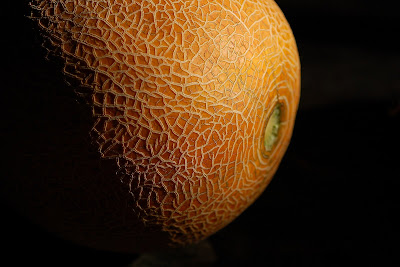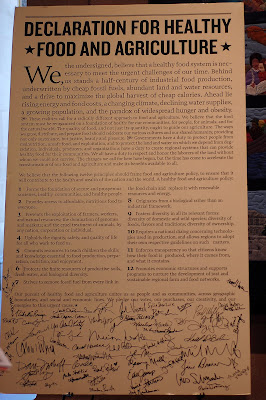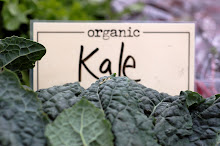
First timers to the farmers' market are an easy spot. They're the ones walking around with hibiscus plants and iris bulbs. They buy dark chocolate covered almonds, marmalade made from fruit that is as difficult to spell as it is to pronounce. They buy the handmade dishes from the woman with artisan honey, a lavender sack to rest upon their eyes. And they need the soothing fragrance once they realize they've spent their grocery money on a flower that won't grow in the fog, a jelly too pricey to eat on ordinary toast and a dish that is crooked. (Note: I love dark chocolate covered almonds and crooked dishes.)
First timers don't see the bunches of kale, rainbows of peppers, potatoes, apples or eggs the color of dirt. They are blind to cucumbers, carrots and cabbage. Who cares about cilantro, cauliflower and corn. What, there's watermelon? Radishes? Broccoli? Get out of my way, they seem to yell rushing past the produce and zeroing in on Swedish waffles, crepes with bananas. They jostle for position in the line for kettle corn, indian food, cheese bread, cinnamon rolls. They stock up on tamales and olive tapenade; taste cheese priced in double digits and buy candles made of beeswax.
The cute guy went to the farmers' market once to do our weekly shopping. I kid you not, he came home with granola, sausages and lettuce. That was it. "It was too overwhelming," he said. He's right. It is.
That's why I will take my first-time-to-the-market friend's money. I don't want them getting home with an empty wallet, nothing to eat and a bad taste. It takes practice to see the real food through the fair like atmosphere. To put on a grocery shopping hat when nothing about the farmers' market resembles what most of us are used to. Except the impulse buys to lure us away from buying plain old real food. Those exist everywhere.
If you're in the market for impulse buys, the farmers' market is the best. Just don't take your grocery money.
And if you're at the farmers' market for groceries, keep your hat on and buy real food first. Then decide if you need a jar of the calamondin marmalde. (It is delicious.)
First Timers at the Farmers' Market
Consider The Farmer

I study the fruit as if I were going to draw it, paint it, as if someone else already committed it to canvas. I notice the places the colors fade, stretch, pull forward, the texture, stem. The places where the juice is held in its miraculous skin.
I consider the farmer that planted the tree. That waited moons and storms for the tree to produce, worried over it, watered and watched it as close I do at my desk. I consider the field worker who picked the fruit, boxed it, put it on the truck for market. And I consider the person I handed my cash to. A simple exchange of smiles, a balancing act of bags in a weathered market with a tent.
It's not until I've lifted the fruit from it's perch, one bite removed, that I reach back for the landscape from which it came. The apples that were barely formed during the California fires. Is there a flavor of the haze that hung over us for days and weeks? And the peaches, they taste like more sunny days then I remember the summer containing. How is that possible? The first fall figs are nearly bland, rushed somehow, hesitant to invest their sugar. What do they know that I don't? I suppose I'll have to watch and see.
It's a small pleasure this one of contemplating the fruit. But it feeds me well.
Farm-Free Salmon Pledge

First, not long after our meal she was at the same restaurant with a friend and before the menus were opened said, "You can't order the salmon!" No further discussion was necessary and I'm still laughing at the story.
Now the Muse has found the Farm-Free Salmon Pledge at Fish restaurant in Sausalito. The pledge encourages restaurants and retailers to remove farmed salmon from their menus and shelves. Individuals can take the pledge too and remove it from their carts and tables.
Fish has printed the Pledge on recycled 5x7 card stock for customers to take and/or distribute. The Muse took the Pledge herself and is taking the card to the restaurant of our not quite legendary no-farmed-salmon dinner. And she gave me several to distribute too.
It's exciting or maybe I'm naive. But I believe if people learn about the impact the farming has on the environment and the facts that farmed salmon is fake and dyed and bolstered up with antibiotics they wouldn't want to support farmed salmon. Let alone eat it.
If you know a restaurant(s) or retailer(s) you would like to have receive the Farm-Free Salmon Pledge card, or you would like some yourself, email me from the sidebar with the business name and address or yours and I'll happily put the Pledge card or cards in the mail.
Let's get busy. There's still a lot of hope to restore the runs of the wild salmon. Delicious wild salmon, I might add.
The Farm-Free Salmon Pledge.
In the spring of 2008, the Pacific Fishery Management Council announced the closure of both the commercial and sport fishing for wild Chinook and Coho Salmon for California and Oregon coasts and rivers. The immediate impact of this will cost the west coast over 200 million dollars and over 4,200 jobs. The long term effects could be much greater if we don’t act now.
Fish. restaurant in Sausalito, Ca. is taking the first step by introducing the Farm-Free Salmon pledge. Restaurants and retailers taking this pledge will remove farmed salmon from their menus and shelves using only wild salmon when it is available. By doing this, they will protect the marine food webs that are plundered to support farmed salmon, prevent the waste that open ocean pens produce, and eliminate the possibility of escape of non-native species into our west coast ecosystems while supporting the fishing communities that depend on healthy oceans and wild salmon populations for their future.
Today, rivers and streams on the Pacific Coast are dammed, degraded, drained, diverted, buried under silt or otherwise unable to support abundant salmon populations. Consequently, some salmon populations that once supported communities along our Pacific coast are severely imperiled to the point where numerous fish populations are now protected by the federal and/or state Endangered Species Acts.
The loss of Pacific salmon populations has damaged coastal and tribal communities all along our coast and inland to Idaho and Nevada. Across the country, families are faced with the choice of paying high prices for wild salmon (if they can be found), or buying farmed Atlantic salmon of dubious quality and nutritional value, or not eating salmon at all. Commercial fishermen have been forced to fish in unsafe weather in order to make boat, insurance, and related payments. Over the last couple of decades, the Pacific Coast commercial fishing fleet has declined from more than 10,000 salmon fishermen to 1,000.
Many of these remaining fishing men and women work second jobs in to order to make ends meet. Native American tribes can no longer depend on the salmon for sustenance as they always have; as a result, these people are suffering skyrocketing increases in heart disease and diabetes. As salmon populations decline, more and more of their food now comes from the grocery store – it is high in starch, fats and sugars.
But salmon are very resilient! If you restore healthy rivers and habitat and give them a half a chance, they will bounce back. Case in point: Sacramento River winter run Chinook salmon nearly went extinct in the early 1990’s; their numbers had dwindled to a mere 186 spawning adults.
Once they were protected under the Endangered Species Act, measures were undertaken to restore habitats in the Sacramento River. Dams were modified to provide cooler water for incubating salmon eggs. A nearby mine that was leaking acid into the Sacramento River was cleaned up. Another dam that was blocking salmon migration was opened. Within a few years of these improvements, winter run Chinook salmon numbers had increased to over 8,000 spawning adults.
The winter run of Sacramento River Chinook salmon is still imperiled; we can restore these populations if we choose to protect and enhance their freshwater habitats.
Creating A World That Can Feed Itself

I delayed what I should have been doing and watched. I was ready for a showdown. And I was ready for Monsanto to say, no, everything that is being said about GMO's is wrong and here's why it's all wrong. That would have been good.
The panel is pitifully short at 36 minutes though. Michael Pollan does a great job of presenting facts. And Hugh Grant is likable. He makes the audience laugh and with his sleeves rolled up talks about how we all have to work together.
None of the big issues of world hunger, the future of seeds or the green revolution in Africa were solved, they were barely addressed in the minutes available but I have my fingers crossed that we can see more public discussions with Monsanto.
I need to know more. We all do.
I'd love to know your thoughts if you have the time to watch.
Green Backlash

I'll have to stop and think. I mean, I've gotten in a rut recently with my one green things. I've begun to justify the actions I take that aren't green as a result of the green habits I do take on. Let me be cliche', one step forward and two steps back. The pendulum of change keeps knocking me in the ass and pushing me in the wrong direction.
Diet coke has tempted its way back into my occasional drink of choice. "Medicinal," I explain to the heavens if no one else is around. Out of the corner of my eye I see the village in India though, with its water supply depleted by Coke. I rehearse the numbers; calories to make, can and distribute the soda compared to the energy calories in the soda. The numbers don't lie - I'm going to hell.
And yes, okay, since I'm already doomed, I'll admit it. I'm back on Starbucks too. Jeez. Is nothing sacred? Double tall lattes'. Put me in jail. They are delicious. I know. I met the tall Guatemalan God who advocates fair trade coffee beans without a middleman. He looked me square in the eye. And I've read about the bean farmers who can't get a fair price for their crops while our corporations grow richer. But, what can I say? Okay, I'll find fair trade coffee in the neighborhood if I'm going to continue to drink coffee. ButinthemeantimeI'mhavinglattes.
See what I mean. I've become petulant. Maybe it's the caffeine.
How are you doing with taking action on a green thing or two? Let me know. I need some momentum to move this backlash in the other direction. Hopefully before tomorrow night.
Tomatillos

Last year I tossed them in a pot with jalapenos, turned the heat on and spooned the resulting sauce into ziplocs for the freezer. I didn't know what I was doing but the bags were in the drawer for reuse by November 3 with a note to put up a lot more this year.
The first tomatillos of any merit I've seen this year showed up at Happy Boy Farm last week. The price was good at a dollar a basket so I smuggled four baskets back to the office in my purse.
Melinda must have read my mind because the next day she posted a roasted tomatillo salsa recipe. The recipe promoted my quick pot of tomatillos and jalapenos to salsa verde muy bien. And muy bien without it being a terrible chore.
I roasted the tomatillos slower than Melinda's recipe but only because the flames from the broiler freak me out. And I put the jalapenos in the oven to roast with the tomatillo believing myself clever until I found pepper skins like corn silk in the finished salsa. The skins didn't effect the taste but they did remind me that occassionally it would be wise to follow directions.
The salsa was so good though I bought more tomatillos on Sunday to repeat the recipe. The biggest problem with eating seasonally however is it tends to not stick to a strict script. The tomatillos were called for instead in a soup of pinto beans along with a mariachi band of jalapenos. We ate them without a thought of the winter ahead, as if summer would be our personal fiesta filling my purse and canvas bags forever.
Hopefully tomatillo harvest will continue a bit longer because I'm only getting started with this juicy green fruit. Or is it a vegetable?
Either way, it's delicious.
The Heirloom Tomato, From Garden To Table

There's a new review by Audrey at Eat Local Northwest of one of my favorite books, Uncertain Peril.
I wrote about seeing the author, Amy Goldman, talk about her new book The Heirloom Tomato, From Garden to Table.
And there's the weekly call for new green reads, reviews, new bookwormers.
Get a few green reading ideas or share some of your own.
Chicken Harvest

But this weekend my ancestral roots grew arms. The cute guy's son, Jeremy, taught me how to harvest chickens. He seems to have been born with an innate knowledge of animals and he did the parts his wife, sister-in-law, and I didn't have the muscle for.
I arrived in my Vote With Your Fork t-shirt, a generation removed from the land but with good information from El at Fast Grow the Weeds. She recently wrote her process of harvesting chickens that gave me not only front row information but confidence too.
It sounds odd to say we had fun but we did. The women, yes, me too, got a little choked up at first. Then we got to work in a rhythm accented by the sounds of scattering chickens, the spray of the hose and the smell of wet feathers. There was respect for each new bird, we harvested a dozen, but it was equally matched with the laughter of working together.
The little kids were in and out too; curious but non-plussed by the operation. They pulled a feather here and there, touched the pimply skin, asked a few questions then ran off half way through the answer.
Jeremy dissected a stomach for his son to see what the chicken had recently eaten. To every one's surprise there was a free range screw.
We had the luxury of working in the barn kitchen for the final step of cleaning the chickens for the freezer. Everyone but Jeremy exclaimed that running water made the job easier. We were able to harvest the necks, livers, hearts and most of the gizzards for stocks or dressings.
It's safe to say I won't take eating chicken for granted again. Something different happened being intimately involved in the process of taking the animals life. My appreciation for the chicken multiplied. Not just for a meaty breast or juicy thigh, but for every part of the bird. Also for the workers that harvest chicken for a living. It's a smelly business.
Have you every hunted, raised and harvested or prepared an animal for food? Was it a good experience? Would you do it again?
Slow Roasted Tomatoes

The grower had said the tomatoes wouldn't get any better than this though. The weather has been hot making the tomatoes naturally juicy. And the time was right for me after the conventions for some peace and quiet preserving.
My plan was to slow roast and freeze the tomatoes. I cut the tops off a couple dozen and arranged them cheek to cheek on the only cookie sheet I own. Then I emptied the cupboards of Pyrex dishes and muffin trays, moved oven racks, arranged more tomatoes, drizzled olive oil over all of them and filled the oven. An empty tomato box of success on the kitchen floor.
After fifteen hours on the lowest oven setting and the tomatoes will be shiny red orbs of summer love in a skin. That was the easy part. I was left with nine dozen tomato tops I hadn't counted on.
I started cutting. Meat side down I sliced four times around the stem leaving a square dime of waste. The remnants were solid, meaty. I started dicing the pieces and filling a bowl for salsa. As much as we love salsa, there was more than we would eat. It's impossible I would even consider the words, too much salsa, but really, there was a lot.
I cooked the remaining tomato top leftovers for dinner; sweet tomato sauce with browned garlic served over fresh spinach and angel hair pasta. My mouth is still sweet from the taste of it and the peaceful afternoon.
My advice to the presidential, and vice presidential candidates: Make sauce, not rhetoric.
Saving At The Farmers' Market

I know that's backwards. It's the other way around, right? No. Not right now. Maybe it's the season. Maybe it's the store. Maybe the cost of taking the produce on a road trip before it gets to the grocery store is going up.
Here's what I found.
Heirloom tomatoes at the grocery store, $4.99 a pound. Farmers' market, $3.25.
Figs at the store, $5.99; from the old guy with the fishing hat, $4.00
Vine ripened tomatoes in the produce aisle, $3.99 a pound; organic dry farmed tomatoes from the man who also grows more varieties of potatoes than I can name, $2.50 a pound.
Grocery store avocados, $2.69 each. Avocados from the nine year old kid at the Sunday market with his Mom, five for $6.00.
I didn't really flip my hair over my shoulder. It's too short and besides I was too busy repeating the prices over and over so I wouldn't forget.
I'd be curious to know if anyone else has compared prices between the grocery store and the farmers' market. Maybe this is the beginning of a trend or a one time fluke. Or maybe the corner store was outrageous to begin with. What have you found?
Food For Thought

Slow Food Nation was just as much fun although several times during the Food For Thought panels I wasn't smiling. I know I live in a San Francisco bubble, but I didn't know farmworkers live in found material and blue tarp shacks built into bushes. That it's happening now. That they often can't afford the food they pick.
I had no idea there are 181 free food pantries in San Francisco.
I didn't know the extent of empty calories being served in school lunch programs; that there are schools with police parked in front of them all day. Likely not eating the food served inside.
It took me by surprise that the Gates and Rockefeller Foundations are investing in GMO seeds to green Africa; that crop yields are expected to decrease due to climate change, that our industrial food systems are not giving us more food by eliminating biodiversity.
And now that I do know these things, what do I do?
I came home and made a pot of brown rice. It's my first solution to everything.
Here's a sampling as random as a dime in a dish of what the panelists offered us to do.
Alice Waters urged us to be hopeful, plant a tree. Michael Pollan asked us to endorse the Food & Agriculture Declaration. He suggested tearing out the front lawn to plant a garden.
Eric Schlosser, with his calm, nearly hypnotic gaze, incited a call for a movement to bring awareness to the exploitation of farmworkers and the people that bring food to our tables. Maricela Morales pleaded with the audience to talk about fair food.
Carlos Petrini with hand gestures that didn't need translation rallied for everyone to meet their farmers. And Vandana Shiva instructed us to keep small farms alive.
Wendell Berry plainly said, "Ask your neighbor what they need. They are useful," he finished.
They were all one good dish.
(I believe the panels will be available at FORA.tv later this week and I will post a link when I see them.)
Here's the first panel discussion of the Food For Thought Series, each of which I'll add to as they become available:
The World Food Crisis
Relocalizing Food
A New Fair Food System
Climate Change and Food
All the Panels at Slow Food Nation
Declaration for Food and Agriculture

We, the undersigned, believe that a healthy food system is necessary to meet the urgent challenges of our time. Behind us stands a half-century of industrial food production, underwritten by cheap fossil fuels, abundant land and water resources, and a drive to maximize the global harvest of cheap calories. Ahead lie rising energy and food costs, a changing climate, declining water supplies, a growing population, and the paradox of widespread hunger and obesity.
These realities call for a radically different approach to food and agriculture. We believe that the food system must be reorganized on a foundation of health: for our communities, for people, for animals, and for the natural world. The quality of food, and not just its quantity, ought to guide our agriculture. The ways we grow, distribute, and prepare food should celebrate our various cultures and our shared humanity, providing not only sustenance, but justice, beauty and pleasure.
Governments have a duty to protect people from malnutrition, unsafe food, and exploitation, and to protect the land and water on which we depend from degradation. Individuals, producers, and organizations have a duty to create regional systems that can provide healthy food for their communities. We all have a duty to respect and honor the laborers of the land without whom we could not survive. The changes we call for here have begun, but the time has come to accelerate the transformation of our food and agriculture and make its benefits available to all.
We believe that the following twelve principles should frame food and agriculture policy, to ensure that it will contribute to the health and wealth of the nation and the world. A healthy food and agriculture policy:
Forms the foundation of secure and prosperous societies, healthy communities, and healthy people.
Provides access to affordable, nutritious food to everyone.
Prevents the exploitation of farmers, workers, and natural resources; the domination of genomes and markets; and the cruel treatment of animals, by any nation, corporation or individual.
Upholds the dignity, safety, and quality of life for all who work to feed us.
Commits resources to teach children the skills and knowledge essential to food production, preparation, nutrition, and enjoyment.
Protects the finite resources of productive soils, fresh water, and biological diversity.
Strives to remove fossil fuel from every link in the food chain and replace it with renewable resources and energy.
Originates from a biological rather than an industrial framework.
Fosters diversity in all its relevant forms: diversity of domestic and wild species; diversity of foods, flavors and traditions; diversity of ownership.
Requires a national dialog concerning technologies used in production, and allows regions to adopt their own respective guidelines on such matters.
Enforces transparency so that citizens know how their food is produced, where it comes from, and what it contains.
Promotes economic structures and supports programs to nurture the development of just and sustainable regional farm and food networks.
Our pursuit of healthy food and agriculture unites us as people and as communities, across geographic boundaries, and social and economic lines. We pledge our votes, our purchases, our creativity, and our energies to this urgent cause.
Please endorse this. You will be in good company and your participation matters.
Thank you.




